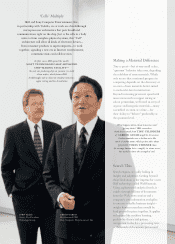IBM 2002 Annual Report Download - page 31
Download and view the complete annual report
Please find page 31 of the 2002 IBM annual report below. You can navigate through the pages in the report by either clicking on the pages listed below, or by using the keyword search tool below to find specific information within the annual report.
29
thomas bradicich
Distinguished Engineer and
Director of Architecture and Technology
eServer xSeries
sheila harnett
Distinguished Engineer
Linux Technology Center
Linux Breaks Out
In 2002, the open software environment called Linux
—
once famously labeled a “bathtub of code”
—
went
primetime. Linux crossed into enterprise applications
in industries from telecommunications to life sciences.
Importantly, governments around the world embraced
Linux and open computing for use in their own infra-
structures and as catalysts for economic development.
Today, more than 75 IBM government customers
—
including ministries and agencies in Germany, Australia,
the United States and Japan
—
are using Linux to cut
costs, increase efficiency and enact e-government
transformations.
more than 15%of the IBM mainframe
capacity shipped in 2002 was for Linux workloads
IBM has engaged with
thousands of customers worldwide,
and has about 7,500 employees working in
porting centers, research, services, development labs,
and the sales and marketing of Linux
The New Idea in Small Systems
They call them “blades,” and not because they’re the
bleeding edge of low-end server computing. Our blades
deliver twice the density and superior management
and integration to the world of rack-mounted systems
—
meaning customers can bring sanity and lower operational
costs to infrastructure sprawl.
IBM is working with
alliance partners
such as Intel, Microsoft, Red Hat, SuSE,
Nortel and Cisco toward
the vision of an industry standard
for blade servers
























